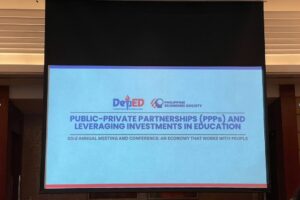The Department of Education (DepEd) said on Friday that it aims to produce 105,000 classrooms and address digital gaps through the Public-Private Partnership (PPP) for School Infrastructure Project (PSIP).
“It will test the core of our governance to deliver these classrooms and the core of our commitment, as a nation, to do right by our learners,” DepEd Undersecretary for Strategic Management Ronald U. Mendoza said in a media event in Makati.
“I’m just trying to emphasize here that we will be proving something as a nation if we are able to get this down, and the best vehicle that we can use is PPPs,” he added.
The PPP framework was adopted by DepEd in 2010 to address the classroom backlog. “We did not change their names anymore, and we’re trying to stick to the old model, which has already been approved almost 12 years ago,” said Mr. Mendoza.
The first phase of PSIP was completed in 2016 and has constructed 9,296 classrooms in regions I, III, and IV-A worth P16.43 billion.
The PSIP Phase 2, on the other hand, costs P3.86 billion and involves the designing, financing, and construction of 4,370 one-storey, two-storey, three-storey, and four-storey classrooms, including furniture, fixtures, and toilets in 1,735 public schools in regions I, II, III, X, CAR, and CARAGA.
“It managed to build 13,391 classrooms, these two tranches,” Mr. Mendoza said.
Following the same framework, the new generation of PSIP targets the construction of 105,000 classrooms from 2026 to 2031.
“This country has never produced 105,000 classrooms in such a short period of time,” the DepEd official said.
The third phase of PSIP aims to construct 15,000 classrooms in regions I, II, III, IV-A, IV-B, V, CAR, and NCR. For PSIP IV, the department targets 40,000 classroom constructions in regions VI, VII, NIR, VIII, and selected areas in Luzon.
Meanwhile, regions IX, X, XI, XII, XIII, BARMM, and other sites not covered by the first two waves are included in the 50,000 target for PSIP V.
“What we tried to do is to first go with the fastest batch of classrooms that can be produced,” Mr. Mendoza said. “And then go through these same regions two more times in order to zero out the deficit in these different provinces.”
Apart from classroom construction, the PSIP also aims to address the digital gap in the sector through PSIP Connect, which aims to disseminate devices, internet connectivity, and power to public schools nationwide.
“The PPPs for classrooms are very important, and we should build them, but it is really digital connectivity that will change the trajectory of our learners,” he said.
The latest classroom backlog in the country, logged at 165,000, is from 2022 data, according to Mr. Mendoza. “We have built some classrooms since 2022, we have also lost many classrooms since 2022, and we have also welcomed new learners since 2022.”
Data from DepEd revealed that Region 4A has the highest classroom shortage at 31,002, while Cordillera Administrative Region (CAR) has the lowest at 2,301.
Mr. Mendoza noted that 54% or 89,050 of the classroom deficit is in Luzon, followed by Mindanao at 31% or 51,445, and Visayas at 15% or 24,948.
“In order for us to reduce that deficit, according to economic math, we must build faster than 11,000 at least,” Mr. Mendoza said.
“We must build faster than 11,000 plus (due to) the classrooms damaged by earthquakes, volcanic eruptions, and typhoons,” he added. — Almira Louise S. Martinez

